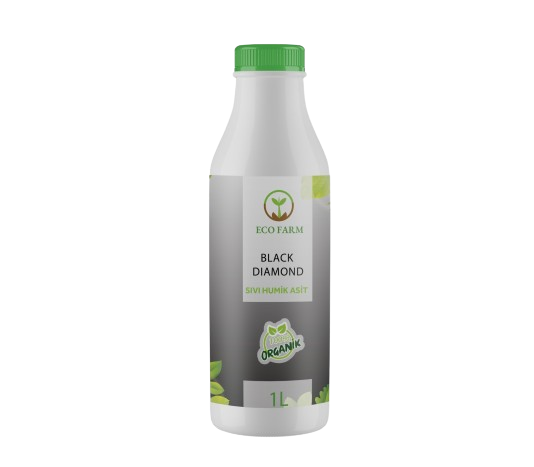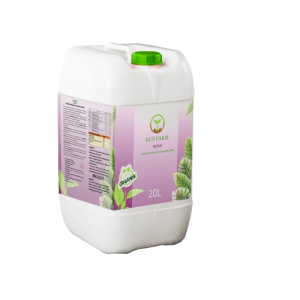ECOFARM BLACK DIAMOND
Humic Acid Liquid
| Content | W/W |
| Organic matter | %15 |
| Total acid (humic + fulvic). | %15 |
| Water-soluble potassium oxide (K2O) | %5 |
| pH | 8-10 |
Humic acid is a naturally occurring compound produced by the decomposition of organic matter in the soil. Liquid humic acid is widely used to increase soil fertility and promote plant growth.
ECOFARM BLACK DIAMOND
Improves Soil Structure: Humic acid fertilizer contains organic matter that improves the soil structure. It increases the soil’s water holding capacity, binds soil particles together and provides good aeration to the soil. This allows plant roots to grow better.
Increases Nutrient Absorption: Humic acid fertilizer ensures better absorption of nutrients in the soil by plants. This stimulates plant growth and increases their productivity. Humic acid makes nutrient molecules soluble, which helps the nutrients in the soil to be more easily absorbed by plants.
Regulates pH Balance: Humic acid fertilizer helps maintain the pH balance of the soil. It regulates the pH of acidic or alkaline soil, allowing plants to better absorb nutrients. This helps plants grow within the pH range they need for optimal growth.
Binds Harmful Substances: Humic acid fertilizer has the ability to bind certain harmful substances in the soil. These can include heavy metals, pesticides and other toxic compounds. Humic acid prevents the plants from absorbing these harmful substances and improves the quality of the soil.
Promotes Microbial Activity: Humic acid fertilizer promotes the growth of beneficial microorganisms in the soil. Microbial activity in the soil increases the ability of plants to utilize nutrients and prevents the formation of diseases. It also helps the microorganisms naturally present in the soil to improve the soil structure.
Area of use, form and time
| plants | Application time | Foliar spray (100 liters of water per acre) |
Soil (from -donum) |
| Tomatoes-Peppers-Eggplant-Cucumbers | Two applications at 15-20 days interval from seedling planting to harvest. | 350-400 | 1,5 – 2,0 |
| Corn and sunflower | 3 times with an interval of 20 days, starting from the period when the plants reach 15-20 cm in height. | 350-400 | 1,0 – 1,5 |
| wheat, barley, rice | 2-3 applications at 15-20 days interval from planting until the end of harvest. | 350-400 | 1,5 – 2,0 |
| Potatoes. Beets. Carrots. | 3 applications at 20 days interval after the first weeding. | 350-400 | 1,5 – 2,0 |
| Beans – Chickpeas and Lentils | Two applications at 15 days interval during the vegetation period. | 350-400 | 1,5 – 2,0 |
| strawberry | 3 times with an interval of 15-20 days starting from the period following fruit setting. | 350-400 | 1,0 – 1,5 |
| Watermelon-pumpkin | 3 times with an interval of 15-20 days starting from the period following fruit setting. | 350-400 | 1,0 – 1,5 |
| In all fruits | First application: before flowering
Second application: after fruit set Third application: until the end of harvest |
2,0 – 2,5 |




Reviews
There are no reviews yet.